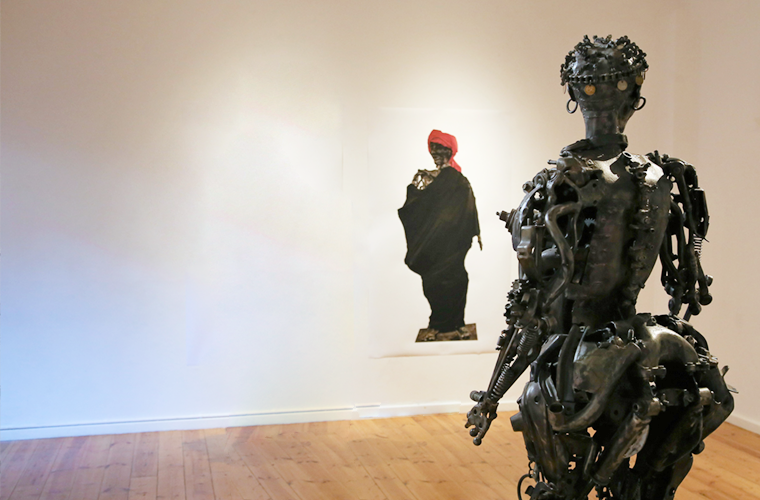Sara ‘Saartjie’ Baartman was born in 1789* at the Gamtoos river in what is now known as the Eastern Cape. She belonged to the cattle-herding Gonaquasub group of the Khoikhoi. Sara grew up on a colonial farm where her family most probably worked as servants. Her mother died when she was aged two and her father, who was a cattle driver, died when she reached adolescence. Sara married a Khoikhoi man who was a drummer and they had one child together who died shortly after birth.
Due to colonial expansion, the Dutch came into conflict with the Khoikhoi. As a result, people were gradually absorbed into the labor system. When she was sixteen years old Sara’s fiancé was murdered by Dutch colonists. Soon after, she was sold into slavery to a trader named Pieter Willem Cezar, who took her to Cape Town where she became a domestic servant to his brother. It was during this time that she was given the name ‘Saartjie’, a Dutch diminutive for Sara.
On 29 October 1810, Sara allegedly ‘signed’ a contract with an English ship surgeon named William Dunlop who was also a friend of Cezar and his brother Hendrik. Apparently, the terms of her ‘contract’ were that she would travel with Hendrik Cezar and Dunlop to England and Ireland to work as a domestic servant and be exhibited for entertainment purposes. She was to receive a ‘portion of earnings from her exhibitions and be allowed to return to South Africa after five years. Two reasons make her ‘signing’ appear dubious. The first is that she was illiterate and came from a cultural tradition that did not write or keep records. Secondly, the Cezar families experienced financial woes and it is suspected that they used Sara to earn money.
Sara Baartman’s large buttocks and unusual coloring made her the object of fascination by the colonial Europeans who presumed that they were racially superior. Dunlop wanted Sara to come to London and become an oddity for display. She was taken to London where she was displayed in a building in Piccadilly, a street that was full of various oddities like “the ne plus ultra of hideousness” and “the greatest deformity in the world”. Englishmen and women paid to see Sara’s half-naked body displayed in a cage that was about a metre and half high. She became an attraction for people from various parts of Europe.
During her time with Dunlop and Hendrik Cezar, the campaign against slavery in Britain was in full swing and as a result, the treatment of Baartman was called into question. Her “employers” were brought to trial but faced no real consequences. They produced a document that had allegedly been signed by Sara Baartman and her own testimony which claimed that she was not being mistreated. Her ‘contract’ was, however, amended and she became entitled to ‘better conditions’, greater profit share, and warm clothes.
After four years in London, in September 1814, she was transported from England to France, and upon arrival, Hendrik Cezar sold her to Reaux, a man who showcased animals. He exhibited her around Paris and reaped financial benefits from the public’s fascination with Sara’s body. He began exhibiting her in a cage alongside a baby rhinoceros. Her “trainer” would order her to sit or stand in a similar way that circus animals are ordered. At times Baartman was displayed almost completely naked, wearing little more than a tan loincloth, and she was only allowed that due to her insistence that she cover what was culturally sacred. She was nicknamed “Hottentot Venus”.
Her constant display attracted the attention of George Cuvier, a naturalist. He asked Reaux if he would allow Sara to be studied as a science specimen to which Reaux agreed. As of March 1815, Sara was studied by French anatomists, zoologists, and physiologists. Cuvier concluded that she was a link between animals and humans. Thus, Sara was used to helping emphasize the stereotype that Africans were oversexed and a lesser race.
Sara Baartman died in 1816 at the age of 26. It is unknown whether she died from alcoholism, smallpox, or pneumonia. Cuvier obtained her remains from local police and dissected her body. He made a plaster cast of her body, pickled her brain and genitals, and placed them into jars which were placed on display at the Musée de l’Homme (Museum of Man) until 1974. The story of Sara Baartman resurfaced in 1981 when Stephen Jay Gould, a paleontologist wrote about her story in his book The Mismeasure of Man where he criticized racial science.
Following the African National Congress (ANC)’s victory in the South African elections, President Nelson Mandela requested that the French government return the remains of Sara Baartman so that she could be laid to rest. The process took eight years, as the French had to draft a carefully worded bill that would not allow other countries to claim treasures taken by the French. Finally, on the sixth of March 2002, Sara Baartman was brought back home to South Africa where she was buried. On 9 August 2002, Women’s Day, a public holiday in South Africa, Sara was buried at Hankey in the Eastern Cape Province.

